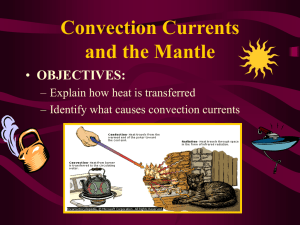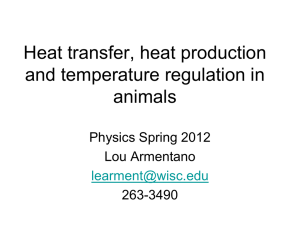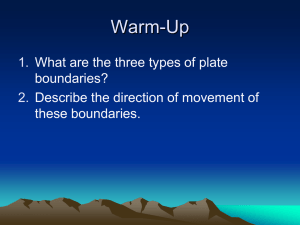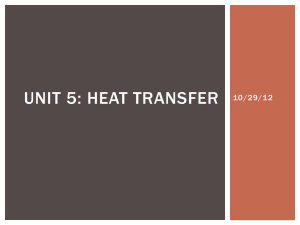06.convection
advertisement
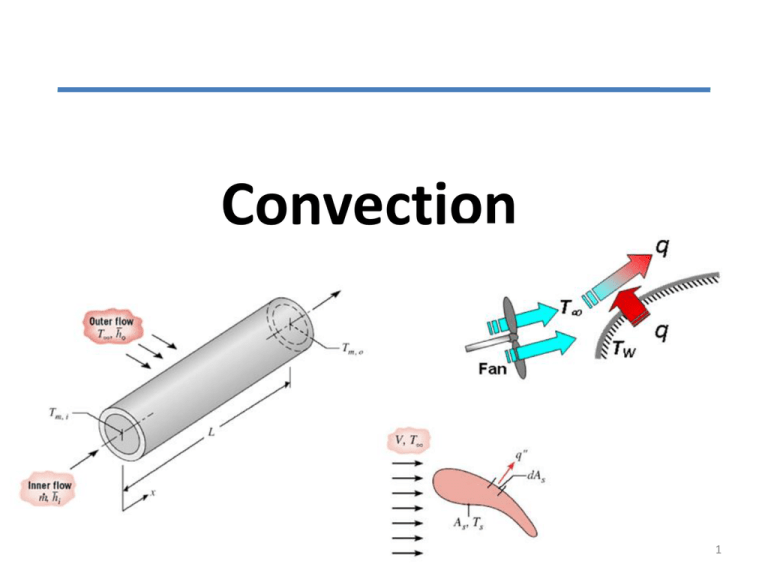
Convection 1 Introduction to Convection • Convection denotes energy transfer between a surface and a fluid moving over the surface. • The dominant contribution due to the bulk (or gross) motion of fluid particles. • In this chapter we will – Introduce the convection transfer equations – Discuss the physical mechanisms underlying convection – Discuss physical origins and introduce relevant dimensionless parameters that can help us to perform convection transfer calculations in subsequent chapters. • Note similarities between heat, mass and momentum transfer. Chapter 6 : Introduction to Conduction – Flow & Thermal Considerations Introduction – Convection heat transfer 3 Chapter 6 : Introduction to Conduction – Flow & Thermal Considerations 6.1 Introduction – Convection heat transfer Forced convection: -is achieved by subjecting the fluid to a pressure gradient (e.g., by a fan or pump), thereby forcing motion to occur according to the laws of fluid mechanics. - Convection heat transfer rate is calculated from Newton’s Law of Cooling where h is called the convective heat transfer coefficient and has units of W/m2K How about natural or free convection ? 4 Chapter 6 : Introduction to Conduction – Flow & Thermal Considerations Introduction – Convection heat transfer Typical values of h are: Natural convection of air = 5 W/m2K Natural convection of water around a pipe = 570 Forced conv. of air over plate at 30 m/s = 80 Water at 2 m/s over plate, T=15K = 590 Liquid sodium at 5m/s in 1.3cm pipe = 75,000 at 370C The heat transfer coefficient contains all the parameters which influence convection heat transfer 5 Heat Transfer Coefficient Recall Newton’s law of cooling for heat transfer between a surface of arbitrary shape, area As and temperature Ts and a fluid: q h(TS T ) Generally flow conditions will vary along the surface, so q” is a local heat flux and h a local convection coefficient. The total heat transfer rate is q AS where q" dAS (TS T ) 1 h AS AS h dAS AS h dAS h AS (TS T ) is the average heat transfer coefficient 14 Heat Transfer Coefficient • For flow over a flat plate: 1 L h h dx L 0 How can we estimate heat transfer coefficient? 15 The Central Question for Convection Convection heat transfer strongly depends on Fluid properties - dynamic viscosity, thermal conductivity, density, and specific heat Flow conditions - fluid velocity, laminar, turbulence. Surface geometry – geometry, surface roughness of the solid surface. In fact, the question of convection heat transfer comes down to determining the heat transfer coefficient, h. This MAINLY depends on the velocity and thermal boundary layers. 8 Chapter 6 : Introduction to Conduction – Flow & Thermal Considerations What is Velocity & Thermal Boundary Layers ? 9 Chapter 6 : Introduction to Conduction – Flow & Thermal Considerations Velocity Boundary Layers – Physical meaning/features A consequence of viscous effects associated with relative motion between a fluid and a surface A region of the flow characterised by shear stresses and velocity gradients. A region between the surface and the free stream whose thickness, increases in the flow direction. why does increase in the flow direction ? - the viscous effects penetrate further into the free stream along the plate and increases Manifested by a surface shear stress, s that provides a drag force, FD 10 Surface Shear Stress Shear stress: Friction force per unit area. The shear stress for most fluids is proportional to the velocity gradient, and the shear stress at the wall surface is expressed as dynamic viscosity kg/ms or Ns/m2, or Pas 1 poise = 0.1 Pa s The fluids that obey the linear relationship above are called Newtonian fluids. Most common fluids such as water, air, gasoline, and oils are Newtonian fluids. Blood and liquid plastics are examples of nonNewtonian fluids. In this text we consider Newtonian fluids only. 11 Kinematic viscosity, m2/s or stoke 1 stoke = 1 cm2/s = 0.0001 m2/s The viscosity of a fluid is a measure of its resistance to deformation, and it is a strong function of temperature. Surface shear stress: Cf is the friction coefficient or skin friction coefficient. Friction force over the entire surface: The friction coefficient is an important parameter in heat transfer studies since it is directly related to the heat transfer coefficient and the power requirements of the pump or fan. 12 Chapter 6 : Introduction to Conduction – Flow & Thermal Considerations Thermal Boundary Layers – Physical meaning/features A consequence of heat transfer between the surface and fluid A region of the flow characterised by temperature gradients and heat fluxes A region between the surface and the free stream whose thickness, t increases in the flow direction. why does increase in the flow direction ? - the heat transfer effects penetrate further into the free stream along the plate and increases Manifested by a surface heat fluxes, q”s and a convection heat transfer coefficient, h If (Ts – T) is constant, how do q”s and h vary in the flow directions ? - The temperature gradient at the wall, h and q”s decrease with increasing x 13 Boundary Layers - Summary • Velocity boundary layer (thickness (x)) characterized by the presence of velocity gradients and shear stresses Surface friction, Cf • Thermal boundary layer (thickness t(x)) characterized by temperature gradients – Convection heat transfer coefficient, h • Concentration boundary layer (thickness c(x)) is characterized by concentration gradients and species transfer – Convection mass transfer coefficient, hm 18 Prandtl Number The relative thickness of the velocity and the thermal boundary layers is best described by the dimensionless parameter Prandtl number The Prandtl numbers of gases are about 1, which indicates that both momentum and heat dissipate through the fluid at about the same rate. Heat diffuses very quickly in liquid metals (Pr << 1) and very slowly in oils (Pr >> 1) relative to momentum. Consequently the thermal boundary layer is much thicker for liquid metals and much thinner for oils relative to the velocity boundary layer. 15 15 Nusselt Number In convection studies, it is common practice to nondimensionalize the governing equations and combine the variables, which group together into dimensionless numbers in order to reduce the number of total variables. Nusselt number: Dimensionless convection heat transfer coefficient. Lc is the characteristic length. The Nusselt number represents the enhancement of heat transfer through a fluid layer as a result of convection relative to conduction across the same fluid layer. Heat transfer through a fluid layer of thickness L and temperature difference T. The larger the Nusselt number, the more effective the convection. A Nusselt number of Nu = 1 for a fluid layer represents heat transfer across the layer by pure conduction. 16 Chapter 6 : Introduction to Conduction – Flow & Thermal Considerations Boundary Layer Transition How would you characterise conditions in the laminar region ? 17 Chapter 6 : Introduction to Conduction – Flow & Thermal Considerations Boundary Layer Transition How would you characterise conditions in the laminar region ? 1. Fluid motion is highly ordered, clear indication of streamline 2. Velocity components in both x-y directions 3. For y-component, contribute significantly to the transfer of energy through the boundary layer 18 Chapter 6 : Introduction to Conduction – Flow & Thermal Considerations Boundary Layer Transition How would you characterise conditions in the laminar region ? 1. Fluid motion is highly ordered, clear indication of streamline 2. Velocity components in both x-y directions 3. For y-component, contribute significantly to the transfer of energy through the boundary layer In turbulent region ? 19 Chapter 6 : Introduction to Conduction – Flow & Thermal Considerations Boundary Layer Transition In turbulent region? 1. Fluid motion is highly irregular, characterised by velocity fluctuation 2. Fluctuations enhance the transfer of energy, and hence increase surface friction as well as convection heat transfer rate 3. Due to fluid mixing (by fluctuations), turbulent boundary layer thicknesses are larger and boundary layer profiles ( v & T) are flatter than laminar. 20 Chapter 6 : Introduction to Conduction – Flow & Thermal Considerations Boundary Layer Transition What conditions are associated with transition from laminar to turbulent flow ? at leading edge of laminar flow, small disturbances are amplified and transition to turbulent flow begins In transition region the flow fluctuates between laminar and turbulent flows. How to classify these type of flows ? 21 Reynolds Number The transition from laminar to turbulent flow depends on the geometry, surface roughness, flow velocity, surface temperature, and type of fluid. The flow regime depends mainly on the ratio of inertial forces to viscous forces (Reynolds number). At large Reynolds numbers, the inertial forces, which are proportional to the fluid density and the square of the fluid velocity, are large relative to the viscous forces, and thus the viscous forces cannot prevent the random and rapid fluctuations of the fluid (turbulent). At small or moderate Reynolds numbers, the viscous forces are large enough to suppress these fluctuations and to keep the fluid “in line” (laminar). Critical Reynolds number, Rex,c: The Reynolds number at which the flow becomes turbulent. The value of the critical Reynolds number is different for different geometries and flow conditions. i.e for flow over a flat plate: 22 22 Chapter 6 : Introduction to Conduction – Flow & Thermal Considerations Boundary Layer Transition - Effect of transition on boundary layer thickness and local convection coefficient 23 Boundary Layer Approximations Need to determine the heat transfer coefficient, h • In general, h=f (k, cp, r, , V, L) • We can apply the Buckingham pi theorem, or obtain exact solutions by applying the continuity, momentum and energy equations for the boundary layer. • In terms of dimensionless groups: Nu x f ( x*, Re x , P r) where: (x*=x/L) Nu f (Re L , Pr) hL hL Nu , Nu kf kf Local and average Nusselt numbers (based Pr Prandtl number ru x Re x on local and average heat transfer coefficients) Reynolds number (defined at distance x) 20 25 26 The Convection Transfer Equations • Motion of a fluid is governed by the fundamental laws of nature: Conservation of mass, energy and chemical species Newton’s second law of motion. Need to express conservation of energy by taking also into account the bulk motion of the fluid. Reminder: Conservation of Mass u y u w x,in ru (dydz) m x,out [ru m (ru)dx]dydz x x Mass balance: All mass flow rates in z - All mass flow rates out = Rate of accumulation Differential Continuity Equation r (ru ) (ru) (rw) 0 t x y z (7.1a) For steady-state conditions (ru ) (ru) (rw) 0 x y z (7.1b) For incompressible fluids u u w 0 x y z (7.1c) Reminder: Conservation of Momentum Rate of = + accumulation of momentum 1. Estimation of net rate of momentum out of element Rate of momentum in Sum of forces acting on system Rate of momentum out y ( r u ) u ( r u ) u dx Ax x x u (ruAx )u m x z 7.15 Reminder: Conservation of Momentum 2. Estimation of forces acting on the element: Pressure, gravity, stresses y yy yy y dy yx xx yx y dy xy xx xy x xy x dx xx dx x yx yy z Stresses are related to deformation rates (velocity gradients), through Newton’s law. Differential Momentum Balance (Navier-Stokes Equations) x-component : 2u 2u 2u u u u u p r u u w rg x 2 2 2 x x y z x y z t (7.2a) y-component : 2u 2u 2u u u u u p r u u w rg y 2 2 2 x x y z y y z t (7.2b) z-component : 2w 2w 2w w w w w p r u u w rg z 2 2 2 x x y z z y z t (7.2c) Conservation of Energy dEst Ein Eg Eout E st dt Energy Conservation Equation z qz+dz qy qx qx+dx x qy+dy y qz (2.1) Reminder: Previously we considered only heat transfer due to conduction and derived the “heat equation” Conservation of Energy Must consider that energy is also transferred due to bulk fluid motion (advection) Kinetic and potential energy E cond , y dy E adv, y dy Work due to pressure forces E cond , x E cond , x dx E g E adv , x E adv, xdx W y x E cond , y E adv , y Thermal Energy Equation For steady-state, two dimensional flow of an incompressible fluid with constant properties: 2T 2T 2T T T T k 2 2 2 q rC p u u w x y z y z x Net outflow of heat due to bulk fluid motion (advection) Net inflow of heat due to conduction 2 2 2 2 u u w u u w 2 where y x x x y z (7.3) rate of energy generation per unit volume (7.4) represents the viscous dissipation: Net rate at which mechanical work is irreversibly converted to thermal energy, due to viscous effects in the fluid
